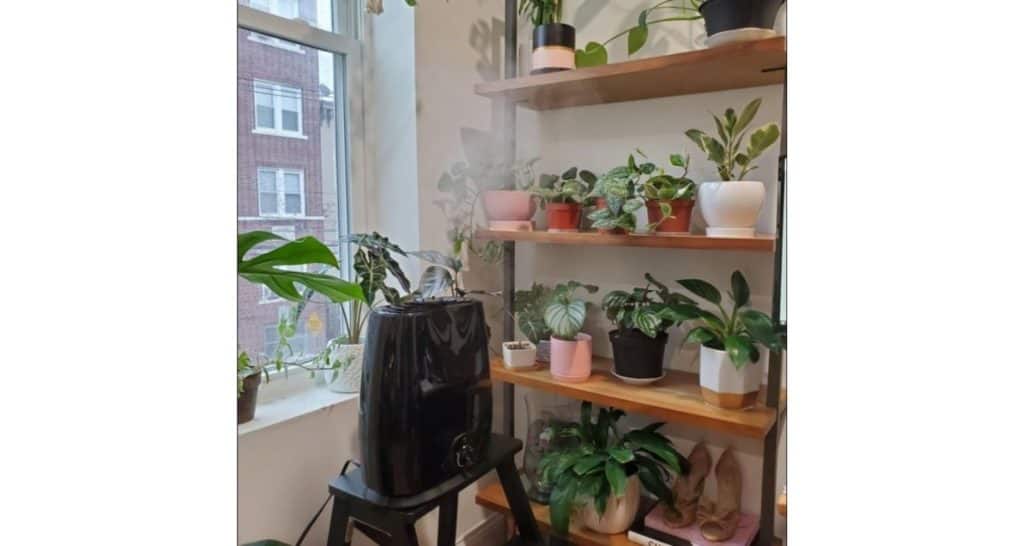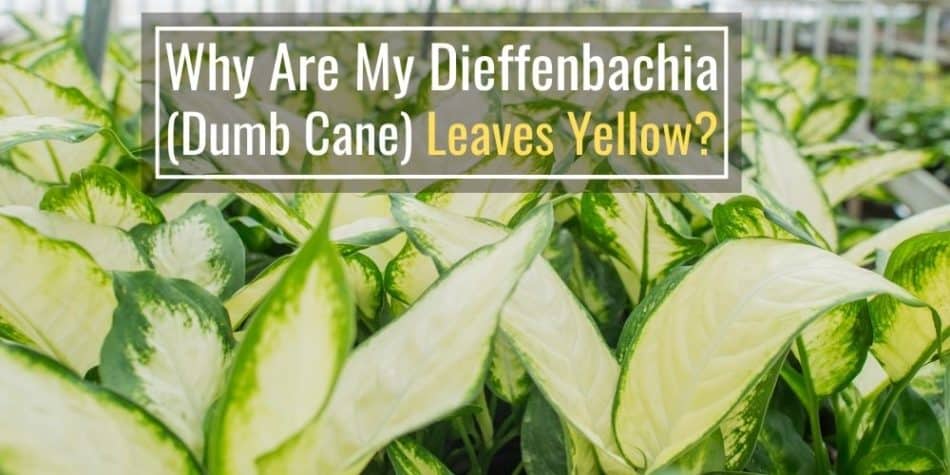If you’re a lover of plant life and seek to add the best nature can offer indoors then chances are you have a Dieffenbachia (Dumb Cane) in your collection.
This gorgeous plant is a popular option amongst plant lovers due to its simple yet beautiful appearance that’s easy to care for and maintain.
However, owners of this plant may also regularly experience the leaves turning yellow on this plant.
So what causes a Dieffenbachia (Dumb Cane) plant’s leaves to turn yellow?
The most common reasons for a Dieffenbachia (Dumb Cane) plant’s leaves to turn yellow are overwatering, underwatering, temperatures above 80°F (27°C) or below 50°F (20°C), and too much direct sunlight. Other reasons for yellowing leaves on a Dumb Cane are low humidity and pests.
This article will shed more light on the topic and present the common reasons why your Dieffenbachia plant leaves change color and possible ways to rectify the issue. Read on!
1. Overwatering
Overwatering is bad for the Dumb Canes because the excessive moisture causes the soil to remain waterlogged.
Waterlogged or wet soil will make it difficult for the Dieffenbachia to absorb air through its roots. If you didn’t already know – plants do absorb air through their roots.
So in other words, a swampy soil around your plant technically drowns the plant since the roots technically function as a plant’s nose for absorbing air molecules from the environment.
Without this vital air, the Dieffenbachia will begin to suffocate which leads to a change in the color of the leaves.
While you may not be a botanist, you can discern if you’ve added too much H2O by dipping your fingers a few inches into the soil.
When To Water A Dieffenbachia (Dumb Cane)
Follow these steps in order to determine when to water a Dumb Cane:
- Insert your index finger into the soil 1 to 2 inches deep
- Feel for moisture
- Water if the soil is dry
- Do not water if the soil is wet or moist
Allow your dumb cane to dry out thoroughly 1 to 2 inches deep before watering the plant. This will help prevent fungi or bacteria to grow in the soil and will allow the plant to breathe the air it needs.
2. Underwatering
While excessively watering your Dieffenbachia can be problematic, refusing to provide sufficient moisture to its roots is also detrimental.
It’s similar to the needs or most living organisms – including humans – too much water will cause overhydration, and too little results in dehydration.
Therefore, forgetting to water your Dieffenbachia for too long will lead to the leaves turning brown or yellow. However, this color change won’t be widespread as it may appear in some leaves but not others.
Dehydration should be easy to spot in a Dieffenbachia since they are very tolerant to dry environments. Therefore, before the leaves turn yellow due to lack of water, the soil would already be crispy and void of moisture.
Additionally, the flower pot will be lighter than usual, giving you a hint that more moisture is needed.
When To Water A Dieffenbachia (Dumb Cane)
Follow these steps in order to determine when to water a Dumb Cane:
- Insert your index finger into the soil 1 to 2 inches deep
- Feel for moisture
- Water if the soil is dry
- Do not water if the soil is wet or moist
3. Extreme Temperatures
The Dieffenbachia doesn’t perform correctly in temperatures greater than 80°F (27°C) and will exhibit stress symptoms if subjected to such heat.
As you may have guessed, yellow leaves are some of the visual signs that the plant cannot metabolize effectively.
However, most rooms are below 80°F on a typical day; therefore, this temperature limit is most relevant during hotter seasons like summer or hot rooms.
As for the cold, dumb cane plants can’t handle anything below 50°F (20°C), meaning they shouldn’t be left in the cold at night or in a freezing room.
Unfortunately, humans cannot accurately measure an object’s temperature by merely looking at it, and for this reason, it’s best to put a thermometer beside the plant or in the plant’s room.
This action will give you a proper reading of your Dieffenbachia and enable you to make quick changes to the temperature when necessary.
Solution for Extreme Temperatures
The best solution is to keep your dumb cane away from areas that have extreme temperatures or tempature fluctuations.
This means its best to keep your plant away from drafty walkways, windows, doorways, and heater vents. All these areas can cause the leaves to curl and turn yellow from the temperature swings.
Another tip is to place your dieffenbachia with other house plants. This way the plants are able to stabilize the temperature and humidity around them which helps all the plants thrive together.
Not to mention having a lot of plants near each other gives a jungle vibe which is very pleasant.
4. Too Much Direct Sunlight
Dieffenbachia (Dumb Canes) are native to tropical regions and are usually found underneath the jungle canopy. This means Dumb Canes are naturally exposed to bright indirect sunlight.
So if the dumb cane is placed in direct sunlight then the leaves may start to curl then turn yellow and eventually fall off.
Too much direct sunlight can cause the leaves to burn which will lead to more serious health issues for dumb canes.
Solution For Too Much Direct Sunlight
Make sure to place the dumb cane in an area that receives bright indirect sunlight such as the corner of a room, staircase or hallway.
If your dumb cane is outside in a pot then place the plant underneath some trees so that it can receive indirect sunlight.
For indoor dieffenbachias, sheer curtains are a great way to dampen the brightness of the sunlight so that the plant’s leaves will not burn. Not to mention sheer curtains add a bit of privacy so these curtains are perfect for plant rooms and any windows facing streets or sidewalks.
5. Low Humidity
A significant feature of some indoor plants is their ability to tolerate low humidity environments; unfortunately, the Dieffenbachia doesn’t appear in this category as its leaves change color in very low humidity.
Plant lovers often experience this problem when transporting their plant from an environment with high humidity to one that’s too low.
This problem may occur when you’re moving to a new apartment or first buying the plant for your room.
Buying the plant from a nursery that provides everything it needs – including the humidity – then transporting it to your home with a less appropriate environment forces the plant to adjust to the new growing conditions.
This adjustment naturally leads to the Dieffenbachia’s leaves turning yellow; however, the good news is that this problem usually disappears with time as the plant adapts to its new environment, causing the leaves to return to normal.
Solution For Low Humidity
One simple solution is to periodically mist your indoor houseplants to increase the humidity. However, this is manual and, personally, I’m too lazy to continually spray my plants every so often.
An easier solution is to place a humidifier in the room with all of your tropical plants. A humidifier will allow you to adjust the settings to provide the right amount of humidity year round.

I use this humidifier in my room and it lasts for about 2 days before needing to be refilled. I highly recommend it for a low maintenance way of keeping the room humid for your houseplants.
6. Pests and Bacteria
If bugs and bacteria decide to turn your healthy Dieffenbachia into their new playground, the infestation and infection can cause the leaves to turn a yellow colour due to irritation and insufficient nutrient supply.
Some of the most common bugs that you may find on your beloved plant’s body include spider mites, mealybugs, and scale. Therefore, you should regularly inspect your plant for bugs or bacteria that won’t stop until the plant is dead.
If you’re not a botanist, one way to know the yellow color is being caused by a sap-sucking bug is to check both sides of the leaf for marks left by the insects. You may be lucky to find the insect on the plant itself; however, bugs like spider mites are so small and tricky to detect that they may destroy your plant before you discover them.
Solution For Pests
If you notice delicate webs on the leaf on your Dieffenbachia, it may be a spider mites.
You can either purchase some natural products to treat the plant with zero adverse effects or create your own homemade insecticidal soapy spray.
My preferred method of getting rid of soft bodied pests such as spider-mites is to thoroughly wash all of the leaves. Allow the plant to dry before spraying the leaves with warm soapy water. Repeat this treatment until the spider-mites are gone.
Read this guide on how to make a plant safe soapy spray since many soaps are actually detergents which can damage your plant’s leaves.
The best part of this homemade soapy spray is that it’s cheap and safe for kids and pets. So I highly recommend trying this homemade spray before trying other methods of pest removal.
Conclusion
Dieffenbachia (Dumb Canes) are great indoor house plants that will liven up any room or walkway.
With some proper care, a Dumb Cane will continue to grow up to 2 to 5 feet tall depending on your variety.
Pay attention to your plant, and it will let you know when something is wrong. Most issues can be resolved when caught early so paying attention to the plant is the most important step.
One other thing to note is that all parts of the Dumb Cane are poisonous. When pruning or handling a Dumb Cane, be sure to use gloves to avoid the milky, toxic sap, and keep your Dumb Cane away from small children or animals who may be inclined to give it more than just a passing glance.
Best of luck plant-parents!

